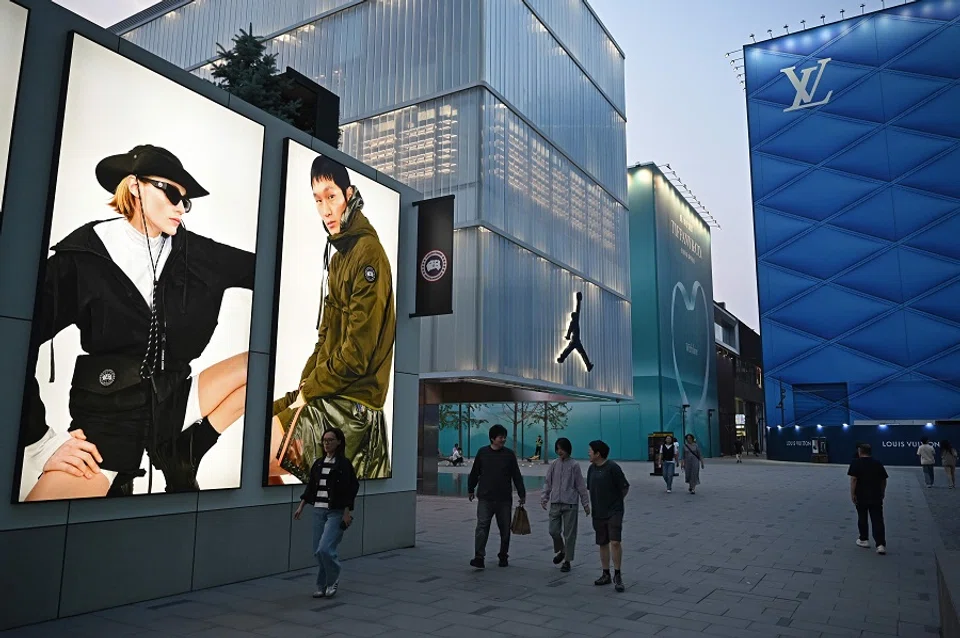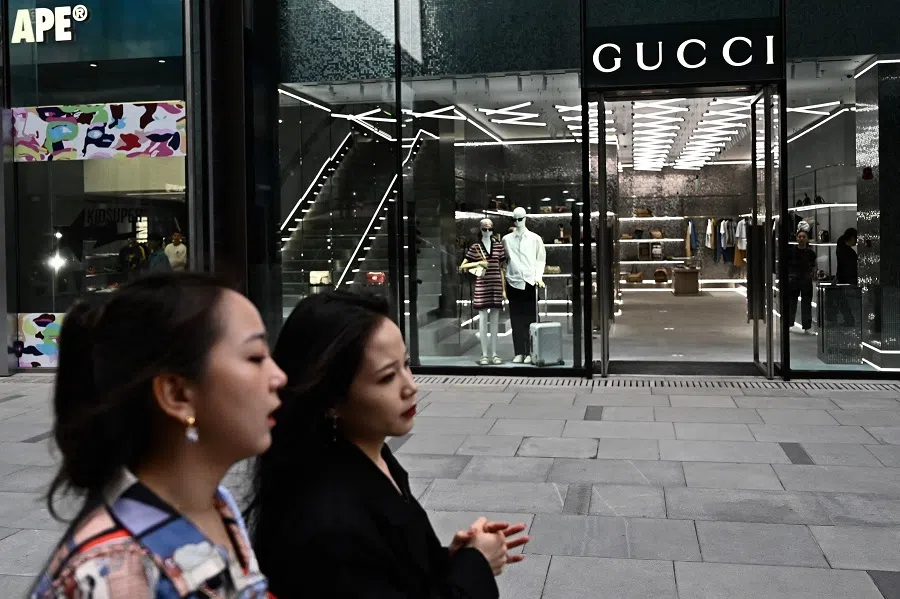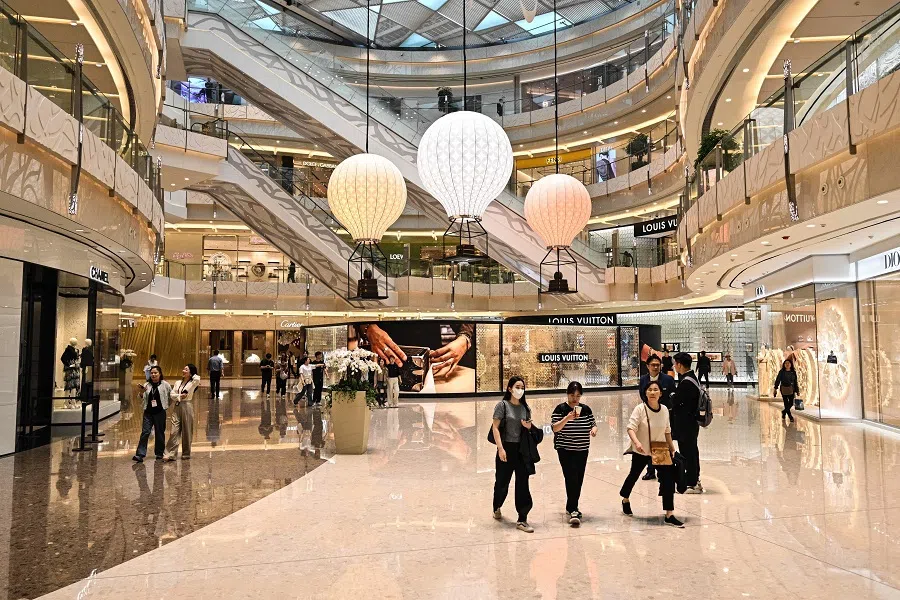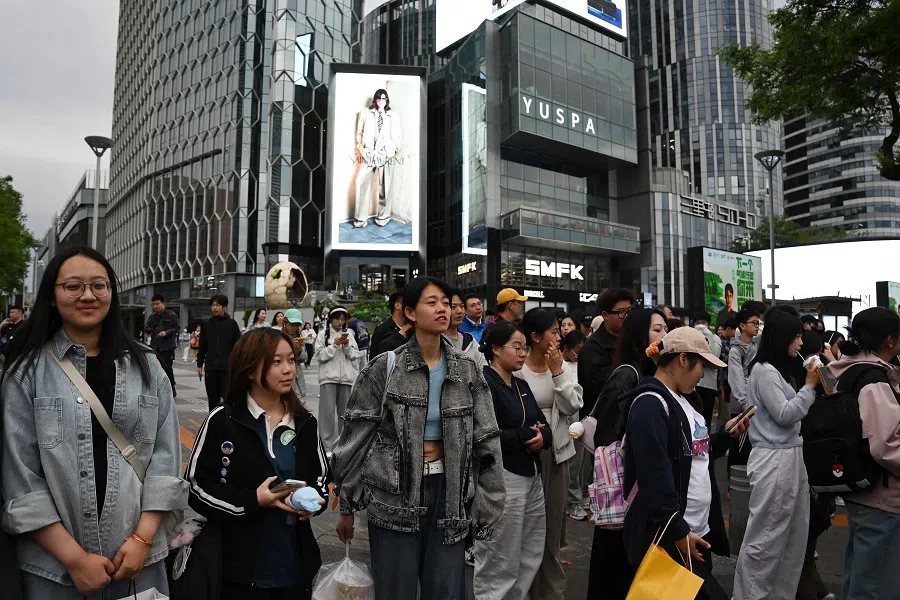Luxury brands close shops across China as domestic demand drops
Once a booming market for high-end fashion, China’s middle class is eschewing luxury goods from designer labels like Louis Vuitton and Chanel, amid economic difficulties such as mass layoffs. Lianhe Zaobao Shanghai correspondent Li Kang tells us more about how these luxury brands are grappling with the downturn.

Yet another luxury boutique has closed down in Shanghai.
Last weekend, while passing by Réel Mall, I noticed that its once eye-catching gilded glass facade had been completely covered by a ten-metre-high advertisement board. Just this past February, this prime shopping location in Shanghai bade farewell to the Italian luxury brand Gucci. Now, barely three months later, French fashion house Balenciaga has also quietly exited the scene.
Beyond the economic hub of Shanghai, this wave of luxury store closures is sweeping through key commercial districts across China — from Taikoo Li in Beijing’s Sanlitun, to Shenzhen’s MixC, Chengdu’s International Finance Square, and Nanjing’s Deji Plaza. Incomplete data reveals that over 30 luxury brands restructured their retail footprint in China during the first quarter of this year, with more than 60% shutting down stores.
Waning demand for luxury goods
Just a decade ago, the Chinese market was still a goldmine for international luxury fashion houses. Take Gucci, for instance: at the height of its expansion, it had as many as 80 stores in China, with nine located in Shanghai alone — twice the number of its outlets in Singapore. But as the economic slowdown continues and consumers tighten their belts, luxury goods are among the first expenses to be cut. This has led to a sharp decline in the performance of luxury brands in China.
Shanghai’s Plaza 66, one of the city’s most concentrated hubs for top-tier luxury labels and the flagship property of Hang Lung Properties, saw its sales revenue drop 22% year-on-year...

For example, Gucci saw its global sales drop by double digits for four consecutive quarters over the past year, dragging down the annual revenue of its parent company, Kering Group, by 12%. Kering was blunt in its financial report, naming sluggish consumer demand in China as one of the key reasons behind Gucci’s continued poor performance.
Judging from the first-quarter financial reports of major luxury groups, the downward trend in luxury consumption shows no signs of stopping. Kering’s revenue fell 14% year-on-year in Q1, for instance, while French luxury conglomerate LVMH posted a 3% decline — its first quarterly drop in nearly three years.
Even the typically resilient Hermès grew only 7%, missing market expectations. Chanel, which released its latest earnings on 21 May, saw its revenue drop 5.3% last year — its first decline since 2020 — with sales in Asia plunging by a steep 9.3%.
Luxury malls also feel the strain
Shopping malls that specialise in high-end luxury brands are also facing tough times. Shanghai’s Plaza 66, one of the city’s most concentrated hubs for top-tier luxury labels and the flagship property of Hang Lung Properties, saw its sales revenue drop 22% year-on-year, according to the company’s latest financial report. Even with an occupancy rate holding steady at an impressive 99%, rental income still fell 6% compared to the previous year.
The outlook is similarly bleak for upscale malls in second-tier cities. Heartland 66 in Wuhan and Forum 66 in Shenyang reported occupancy rates of less than 90% last year, while their sales plunged by 22% and 25% respectively, highlighting that even the once-promising second-tier luxury markets are cooling rapidly.
One major reason for the retreat of luxury consumption in China is the contraction of the middle class that once chased after these brands.

The chill in the financial reports aligns closely with what is happening on the ground. On Saturday, crowds still thronged Nanjing Road’s pedestrian street, but very few people were carrying shopping bags. Inside the malls, luxury boutiques were quiet, with only a few sales assistants standing idly at the entrances. Once-popular stores that used to have queues to get in now open their doors to anyone who walks by.
On the job networking platform Maimai, one laid-off employee shared their monthly expenses: a 21,000 RMB mortgage, 80,000 RMB a year for international school tuition and 5,000 RMB a month for parents’ medical bills.
China’s shrinking middle class
One major reason for the retreat of luxury consumption in China is the contraction of the middle class that once chased after these brands. A longtime sales associate in Beijing told Chinese media that the middle-class customers who used to spend between 20,000 and 40,000 RMB (US$2,776 to US$5,552) a year at her store have “almost disappeared”. “Many big companies have laid off staff, it’s harder to make money now, and people are spending more rationally,” she said.
Over the past few years, sectors such as private education, real estate and internet technology in China have undergone multiple waves of layoffs. Even internet giant Alibaba has continued to scale back. According to its financial statements, the company had nearly 255,000 employees in 2022, but that number had dropped to below 205,000 by the end of March last year.
The disappearing headcounts in corporate financial reports happen to represent the very backbone of China’s middle class. On the job networking platform Maimai, one laid-off employee shared their monthly expenses: a 21,000 RMB mortgage, 80,000 RMB a year for international school tuition and 5,000 RMB a month for parents’ medical bills. In the face of a rapidly shrinking bank balance, even a luxury handbag — once affordable with half a month’s salary — is now out of reach. Until a new job is found, even buying a drink from Starbucks might require serious thought.
... with a cooling property market, tightening job prospects and global instability, the risks facing China’s middle class appear particularly acute.

A more extreme case is Lin Yuan, known online as “Coder Sister No. 3” (程序媛三妹), who described herself in short videos as “the most down-and-out graduate of a top-tier 985 university”. Now 32, Lin has spent six years working in Beijing and has already been laid off three times. The apartment she bought for 5.11 million RMB has dropped in value by about 700,000 RMB. “The years of scrimping and saving now feel like a joke.”
To be fair, the contraction of the middle class is not unique to China. An article on the World Economic Forum’s website noted that the middle class in the US has shrunk from 61% of the population in the 1970s to 51% today, while the middle class has contracted by nearly two-thirds over the past 15 years in the EU. In Asia, there is growing concern over whether the middle class can recover from the impact of the Covid-19 pandemic. But with a cooling property market, tightening job prospects and global instability, the risks facing China’s middle class appear particularly acute.
Seen from another perspective, however, they are also using the opportunity to embrace a different way of life as they shed their infatuation with luxury brands — one that strips away excess and redefines what truly matters.
A shift in priorities
This demographic — once beneficiaries of China’s economic boom and key players in its upward mobility — is now bearing the brunt of the country’s economic transformation. Seen from another perspective, however, they are also using the opportunity to embrace a different way of life as they shed their infatuation with luxury brands — one that strips away excess and redefines what truly matters.
McKinsey’s latest report observed this shift as well: rather than waiting for a resurgence in consumer confidence, most Chinese consumers are proactively adjusting their expectations; they are not hoping for a return of rising incomes, but are instead re-evaluating the real value of every expense. Behind this wave of consumer downgrading lies a quiet transformation in the values of China’s middle class, which could give rise to a new life philosophy. Perhaps that is also something good.
This article was first published in Lianhe Zaobao as “奢牌退潮时”.



![[Big read] China’s 10 trillion RMB debt clean-up falls short](https://cassette.sphdigital.com.sg/image/thinkchina/d08cfc72b13782693c25f2fcbf886fa7673723efca260881e7086211b082e66c)

